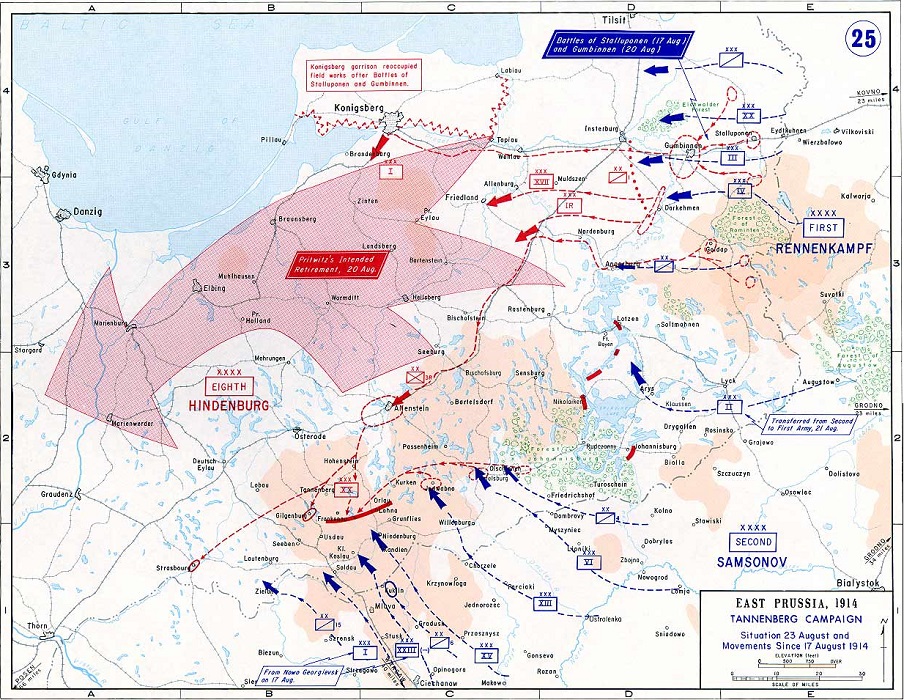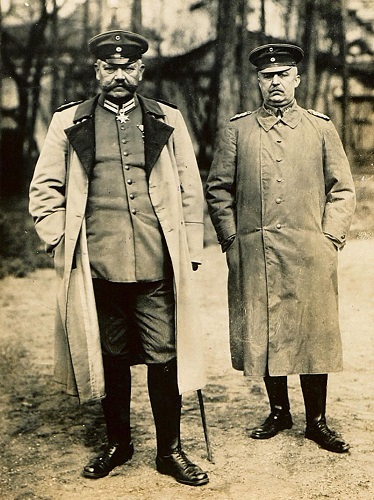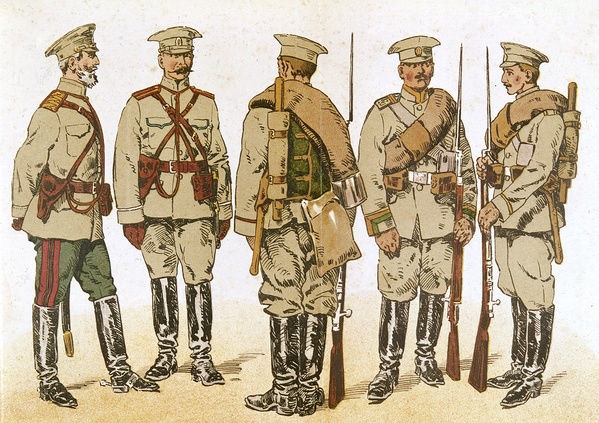● ● ●
For clarity, German units are
rendered in italics.
As the
Austro-Hungarian armies marched across Galicia toward their
rendezvous with disaster, Russian troops commenced the
invasion of East Prussia. General of Cavalry Pavel
Rennenkampf’s First Army crossed the frontier on 17 August,
rather earlier than the Germans had expected. This was the
northern prong of the Russian offensive, directed against
Königsberg. On 18 August its vanguard was repulsed with
heavy casualties by Eighth Army’s I Corps
(Lieutenant-General Hermann von François) around the town of
Stallupönen, some ten miles inside the East Prussian
frontier. But he had attacked without orders and when
Colonel-General Maximilian von Prittwitz und Gaffron,
commanding Eighth Army, heard what had happened he
ordered François to break off the battle and retire.
Prittwitz intended to concentrate his forces some ten miles
farther west, around the town of Gumbinnen. Not without
protest, François complied with the Eighth Army
commander’s orders. Once his corps vanished from their
front, the Russians resumed their advance.
By 20
August, Prittwitz had the bulk of his army drawn up in the
vicinity of Gumbinnen: I Corps on the left, XVII
Corps (Lieutenant General August von Mackensen) in the
center and I Reserve Corps (Lieutenant-General Otto
von Below) on the right—six infantry divisions and a cavalry
division in all. Intercepted radio messages (the Russians
were blithely transmitting in the clear) indicated that
Rennenkampf had declared a rest day for his army on 20
August, so Prittwitz decided to attack.

Department of History, USMA West Point
On the
left after a hard fight, I Corps gained the upper
hand over Russian XX Corps but in the center things went
wrong. Mackensen committed XVII Corps to a frontal
attack that broke down after heavy fighting. Under violent
fire from the Russian artillery the German infantry panicked
and fled. Prittwitz thereupon ordered I Corps and
I Reserve Corps to retire also. That evening he
telephoned Moltke at OHL to announce that Eighth Army
had been defeated at Gumbinnen and would probably be
compelled to retreat behind the Vistula River, abandoning
East Prussia completely. Prittwitz’s alarm was compounded by
the news that Russian Second Army (General of Cavalry
Alekesander Samsonov), with five corps and three cavalry
divisions, had commenced its attack out of the Polish
salient, moving northwest into East Prussia. There was
nothing south of the Angerapp-Stellung to oppose the
Russians except the two divisions of XX Corps
(Lieutenant-General Friedrich von Scholtz) and some
Landwehr troops. Fearing that Second Army’s advance
would cut the rear communications of the German forces
standing against First Army, Prittwitz succumbed to panic.
Late that evening he telephoned Moltke again, confirming his
decision to quit East Prussia.
Though
the possibility of losing East Prussia had always been
recognized, Moltke shrank from its consequences. To yield
the ancient heartland of the Hohenzollern monarchy in the
first weeks of the war would deal an enormous psychological
blow to the Army and the nation. Agitated protests poured
into OHL from East Prussian landowners and even from the
Kaiser himself. General von François, who was convinced that
the situation was not as dire as Prittwitz supposed,
protested directly to the monarch against the proposed
withdrawal. On 21 August, therefore, Moltke decided that
Prittwitz and his chief of staff, Major General Alfred von
Waldersee, had to go. Looking around for suitable
replacements his eye fell on one Major-General Erich
Ludendorff, a man who had recently made his mark in the
west, during the siege and capture of the Belgian fortress
of Liege. But Ludendorff was too junior to be given command
of Eighth Army; he would be made its chief of staff.
For the army’s new commander Moltke resorted to the retired
list. From it he selected the 67-year-old Colonel-General
Paul Ludwig Hans Anton von Beneckendorff und von Hindenburg,
a veteran of the Franco-Prussian War with a solid
reputation. In response to Moltke’s telegram inquiring when
he could report for duty, Hindenburg responded tersely, “Am
ready.” Still wearing the obsolete blue uniform of a
Prussian general (he had not had time to be fitted for the
new field gray) Hindenburg joined Ludendorff on the train
that was to carry them both east.

Hindenburg (left) and
Ludendorff
on the Eastern Front (Bundesarchiv)
Meanwhile, ignorant of the fact that he was about to be
sacked, Prittwitz had somewhat recovered his balance. Thanks
to aerial reconnaissance, supplemented by the Russians’
habit of transmitting radio messages in the clear, he had
good information about his opponents’ dispositions and
intentions—knew, for example, that despite having gotten the
better of the fighting at Gumbinnen, First Army was doing
nothing. The offensive into East Prussia had been launched
before the Russian armies’ supply services were fully
mobilized—this in response to insistent French pleas for
early action—and Rennenkampf judged that his army’s
logistical problems ruled out an immediate advance. Making
matters worse, a difference in gauges meant that Russian
trains could not use the East Prussian rail net. It was thus
proving doubly difficult to bring forward the rations,
fodder, ammunition and replacements that his army needed.
Farther south, Samsonov’s Second Army was experiencing
similar problems as it marched into East Prussia.
Armed
with this knowledge his staff proposed, and Prittwitz
agreed, to leave only a thin screen of cavalry and
Landwehr troops facing First Army. The bulk of Eighth
Army would move south to confront Second Army, an
operation made possible by efficient staff work and the
well-managed East Prussian rail net. This was the situation
on 23 August when Hindenburg and Ludendorff arrived at
Eighth Army headquarters—bearing the news to Prittwitz
and Waldersee that they had been dismissed. Thus was the stage set for the storied Battle of Tannenberg.



